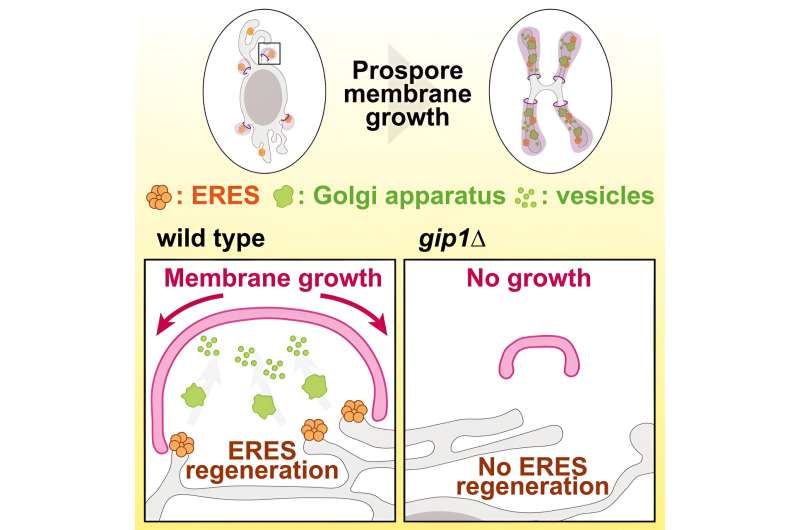This article has been reviewed according to Science X's editorial process and policies. Editors have highlighted the following attributes while ensuring the content's credibility:
fact-checked
peer-reviewed publication
trusted source
proofread
Elucidating the mechanism underlying de novo membrane formation during gametogenesis

Researchers at University of Tsukuba have meticulously examined the gametogenesis of budding yeast, a process involving meiosis and spore formation, using live imaging techniques. Their findings reveal that during sporulation, the endoplasmic reticulum exit sites, which represent the starting points of the secretory pathway, are remodeled. This remodeling enables cells to efficiently transport proteins and membrane lipids, facilitating the formation of nascent spore membranes.
A paper describing their research is published in the journal iScience.
Sexual reproduction, a common mode of reproduction among numerous species, involves gametogenesis in which offspring are produced through fertilization, conjugation, or mating.
In plants and animals, eggs and sperm differentiate from germ cells to form gametes. However, in budding yeast, spores are produced within diploid cells. During this process, de novo membrane structures form within the cytosol, encapsulating the meiotic haploid nuclei to produce spores.
Despite having this knowledge, researchers do not clearly understand the precise mechanism underlying the formation of these nascent membrane structures.
To gain insights into this process, researchers at the University of Tsukuba used live imaging techniques to meticulously observe meiosis and sporulation in budding yeast, capturing the development of nascent membrane structures within cells.
They observed that although the endoplasmic reticulum (ER) exit sites and Golgi apparatus declined in numbers, they reassembled during sporulation. Furthermore, they identified Gip1, a meiosis-specific subunit of type 1 protein phosphatase, as a key molecule affecting this regulatory mechanism.
In Gip1-deficient cells, the secretory pathway could not be precisely located due to the defects in regenerating ER exit sites, resulting in the formation of abnormal spore plasma membranes. This finding suggests that cells efficiently transport membrane lipids and produce new cell membranes by reorganizing membrane traffic pathways during sporulation.
The results of this research have significant implications for human health, as numerous diseases related to gametogenesis and fertilization are caused by abnormalities in intracellular membrane traffic.
These findings can potentially enhance the current understanding, diagnosis, and treatment of related pathogenic mechanisms.
More information: Yasuyuki Suda et al, Remodeling of the secretory pathway is coordinated with de novo membrane formation in budding yeast gametogenesis, iScience (2024). DOI: 10.1016/j.isci.2024.110855. www.cell.com/iscience/fulltext … 2589-0042(24)02080-7
Journal information: iScience
Provided by University of Tsukuba


















